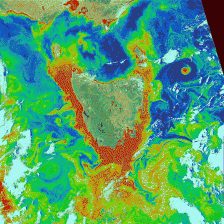2) Climate is regulated by complex interactions among components of the Earth system.
 Complex interplay of seawater: Satellite image of the ocean near Tasmania, showing complex ocean currents, driven by the movement of the earth, solar radiation, air currents, and other factors.
Complex interplay of seawater: Satellite image of the ocean near Tasmania, showing complex ocean currents, driven by the movement of the earth, solar radiation, air currents, and other factors.The second principle refers to the complexity of the climate system and how various cycles, particularly the hydrologic and carbon cycles, and “-spheres,” such as the hydrosphere and atmosphere, influence climate.
One of the key dynamics discussed is the naturally occurring “greenhouse effect,” which was first investigated in the 1850s through laboratory experiments conducted by John Tyndall and is well understood by climate scientists today. The greenhouse effect’s dynamics are not exactly like a greenhouse, where heat builds up by suppressed convection. In the atmosphere, the amplified warming occurs through another process: certain long-lasting gases, most notably carbon dioxide, absorb and re-radiate the outgoing infrared heat, warming the planet more than would be the case otherwise. Without this extra warming, the average temperature on Earth would be significantly colder than it is today, about 0°F (-18°C), rather than the present global average of 59°F (15°C).
The complexity of the climate system means that climate phenomena do not necessarily occur in a simple linear manner. Due to feedbacks and interactions among different components of the earth system, changes in one system can amplify the effects on the climate system. For example, consider the loss of sea ice in the Arctic — 2007 was the lowest extent for summer sea ice on record, with 2011 a close second. With less sea ice, less incoming energy from the Sun is reflected back toward space, and more is absorbed as heat by the Arctic ocean. This creates a feedback loop that accelerates the melting of more ice.
Complex interactions are by nature difficult to understand, and this is another area where learners struggle and those intent on sowing doubt or denial often use quasi-scientific jargon to muddy the waters around the complexity of the climate system.
CLEAN’s “Teaching Essential Principle 2” provides overview of the content, why it is important, related pedagogical challenges, and examples of high quality resources by grade level.
Continue to the next section to find out how life on Earth depends on, is shaped by, and affects climate.
